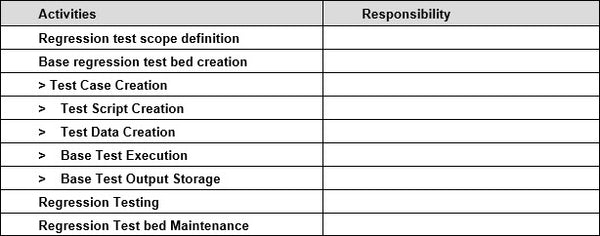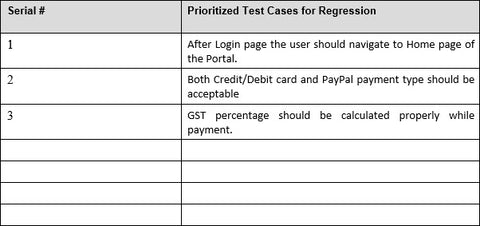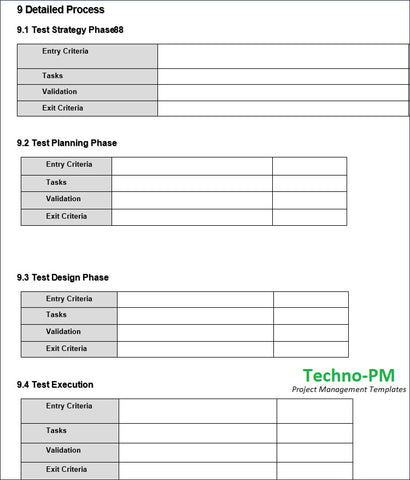Regression Test Plan Template
Introduction
Regression testing is performed after making a functional improvement or repair of software. Its purpose is to determine if the change has affected other aspects of the software. Regression tests give assurance to systems management, developers, testers, and users that the new system is not impacted any way by the change.

The Necessity of a Regression Testing Plan
- Regression testing helps detect errors in the development cycle, thereby avoiding the often hidden (but quite significant) costs of the numerous problems encountered and reported when a bug-laden application is moved into production.
- Lack of regression testing had a serious negative impact on the integrity of the system.
- Industry estimates indicate that approximately 30% of the bugs in an application are found during regression testing.
- Requirement change and code change is modified according to the requirement.
- The new feature is added to the software.
- Defect fixing.
- Performance issue fix.
Features of Regression Test Plan Template
Retest All: This is one of the methods for Regression Testing, which is tiresome and tends to waste lots of time. This is a very high budget as it requires huge time and resources. It involves testing all the features of the product even where no modifications are made. This one is not the smart way to carry out regression testing.
Regression Test Selection:
- Test cases selected can be classified as Reusable Test Cases and Obsolete Test Cases.
- Re-usable Test cases can be used in consecutive regression cycles.
- Obsolete Test Cases can't be used in consecutive cycles.
- It is a better option to select the prime part of the test suite instead of re-executing the whole test suite.
Prioritization of Test Cases
Prioritization of test cases is an important aspect as it will greatly reduce the regression test suite. Prioritize the test cases depending on business needs, critical & frequently used functionalities. Preferring those test cases which have more priority.
Selecting Test Cases For Regression Testing
Productive Regression Testing can be done by selecting the following test cases -
- Functionalities which has more visibility to the users.
- All Integration Test Cases.
- All Complex Test Cases.
- Boundary value test cases.
- A sample of Successful test cases.
- A sample of Failure test cases.
- Test cases that have frequent defects.
- Test cases that verify core features of the product.
- Test cases of Functionalities which has undergone more and recent changes
- Identify Problematic Area

Prioritized Test Cases Sample
Types of Regression Testing
Corrective Regression Testing:
Use of this testing is done when there are no changes added in the product’s specification. Moreover, the already existing test cases can be easily reused to conduct the desired regression test.
Progressive Regression Testing:
This type of regression testing works productively when specific changes are done in the program requirement, and new test cases are designed. Carrying out this testing helps confirm that there are no features in the previous version that have been ignored in the latest and updated version.
Unit Regression:
Unit Regression is done during the unit testing phase that is just after the development and code is tested in isolation, i.e., any dependencies or interactions on the unit to be tested are blocked at this time.
Partial Regression:
Partial regression is done when new codes are added to verify that the code works fine and the system is performing as it is supposed to perform even when the changes have been done in the code, and that unit is integrated with the unchanged or already existing code.
Complete Regression:
Complete Regression testing is done when a code change is done on several modules, or there are multiple changes and has a certain impact on the system's root cause. It is done to detect unexpected issues. This testing ensures a final availability to the user.
End to end testing is done by running automated E2E regression tests against the said application.

Regression Test Plan Segment
Use of Regression Testing Tools/Automation Tools
If there are frequent changes in the software, the regression testing will cost you a high budget. As manual execution of these test cases will increase test execution time as well as cost. Automating these regression test cases will be a fulfilling choice in such cases. Many tools are available for Automation. Following are some important tools used for both functional and regression testing:
Selenium:
This is an Automation tool or testing framework which is open source. It supports almost all languages like Java, C#, Python, Ruby, Pearl, Groovy, etc. It supports many browsers like Chrome, Firefox, Safari, and platforms like Mac, Windows, Linux, and is used for automating web applications. Selenium can be considered helpful in browser-based regression testing.
HPE UFT( Unified Functional Testing)(Formerly QTP):
It offers automation testing for both functional as well as regression testing for software applications. The language used by this tool is VB Script. It offers Unique Smart Object Recognition, Automated documentation, an error handling mechanism, the Creation of data-driven tables; checkpoints; parameters for objects.
Challenges in Regression Testing
Following are the major testing challenges while doing regression testing:
- Frequency of Regression Tests is determined and, i.e., after every modification/Change in requirement or every build update or after a bunch of defect fixes, is also a challenge.
- With consecutive regression runs, test suites become large. Due to high time and high budget constraints, the entire regression test suite becomes impossible to be executed.
- Minimizing the test suite using prioritization and selective process while achieving maximum Test coverage remains a challenge.
- Need to have Knowledge of existing applications.
Guidelines To Use Regression Test Plan Template
- Provide your project details like project name, date, version at the specified place.
- Provide the Document details at their specified place.
- Can add, edit or delete the contents according to your needs after downloading the template and saving it in your system. It is also highlighted in blue italics format where the content can be added.
- There are specific tables for every section to make it easier for the Template user to fill in the details.
- Fill in the tables according to their row and column heading.



